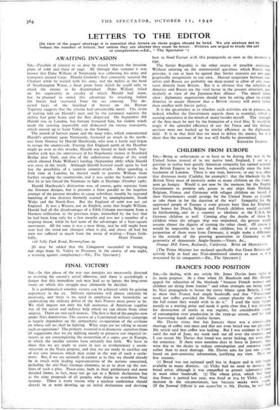LETTERS TO THE EDITOR
[In view of the paper shortage it is essential that letters on these pages should be brief. We are anxious not to reduce the number of letters, but unless they are shorter they must be fewer. Writers are urged to study the art of compression.—Ed., " The Spectator ••1
AWAITING INVASION
Sut,—Parallels of interest to us may be traced between the invasion plans of 1066 and those of 1940. All through that summer it was known that Duke William of Normandy was collecting his army and transports around Caen. Harold Godwin's fleet constantly scoured the Channel while he waited with his army and the militia at the head of Southampton Water, a focal point from which he could sally to attack the enemy as he disembarked. Duke William relied on his superiority in cavalry of which Harold had none, but he planned to annul this advantage by attacking before the horses had recovered from the sea crossing. The de- jected faces of the boatload of horses on the Bayeux Tapestry suggests that the scheme had considerable merit. The strain of waiting told on Harold's men and by the autumnal equinox the militia had gone home and the fleet dispersed. On September 8th Harold was in London, but fortune favoured him, for violent winds made the crossing impossible and dislocated the enemy transports, which moved up to Saint Valery on the Somme.
The month of harvest moon and the neap tides, which concentrated Harold's attention upon Normandy, favoured an attack in the north- east from Norway by Harold Hardraada, who won a battle and began to ravage the countryside. Fearing that England north of the Humber might go over to this invader, Harold was forced to dash north. Sep- tember 25th was the anniversary of his Napoleonic victory at Stamford Bridge near York, and also of the unfortunate change of the wind which allowed Duke William's landing (September 28th) while Harold was away in the north. Although Harold hurried south again he had lost the possibility of a surprise counter-attack. After spending a little time in London, he moved south to prevent William from further ravaging the countryside, and it was under the hunter's moon that he at last forced the Normans to fight at Hastings (October 14th).
Harold Hardraada's distraction was, of course, quite separate from the Norman designs, but it presents a faint parallel to the hopeless attempt of the present invaders to cause subsidiary trouble by repeated bombing of two districts formerly scarred by unemployment, South Wales and the North-East. But the England of 1066 was not yet England. It was a Wessex, not an English, army that fought William. Harold had all the disadvantages of a Fifth Column movement from a Norman infiltration in the previous reign, intensified by the fact that he had been king only for a few months and was not a member of a reigning house, while he had none of the advantages of a four-square movement. All the same it was a near thing, and he still might have won had the wind not changed when it did, and above all had his men not suffered so much from the strain of waiting.—Yours faith-
fully, MARY FISHER. 128 Selly Park Road, Birmingham 29 [It may be added that the Conqueror succeeded in bringing 696 ships from St. Valery to Pevensey in the course of one night, a warning against complacency.—En., The Spectator.]


























 Previous page
Previous page